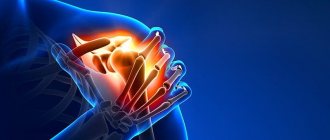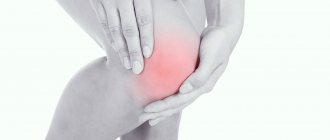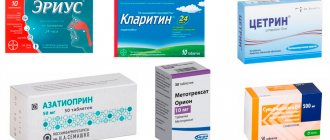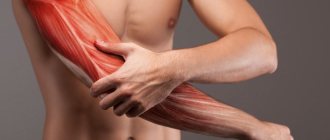Causes of pain in the shoulder joints
There are many reasons for the appearance of painful sensations. Pain in one or both shoulders can be a consequence of inflammation of the tendons, microtrauma of the articular cartilage, inflammatory-degenerative pathologies of the joints and cervicothoracic spine. The discomfort can be either minor or so intense that you cannot move your arm.
Among the causes that cause sharp or aching pain in the shoulder are:
- one-sided intense load for a long time;
- scoliosis, lordosis and other deviations in the normal position of the spine;
- physical inactivity.
In addition, pain can occur due to infections, inflammatory processes, hereditary predisposition, diseases of internal organs, and tumors.
In cases where the right shoulder hurts, the following pathologies may be present:
- Tendonitis is inflammation of tendons and soft tissues due to significant physical activity.
- Myositis - when the muscles of the shoulder joint are involved in the inflammatory process.
- Arthrosis is the destruction of articular cartilage.
- Arthritis is an inflammatory process in a joint due to infection, allergic reaction or autoimmune diseases.
- Osteochondrosis of the cervical spine.
- Bursitis is an inflammation of the joint capsule.
- Capsulitis is a pathological change affecting the joint capsule and synovium.
- Brachial nerve neuritis.
- Tuberculous lesion of the joint on the right.
- Humeroscapular periarthritis.
- Metastasis from a nearby tumor.
- Chondrosarcoma.
- Right-sided pneumonia.
Pain in the left shoulder joint is much less common, especially if the person is right-handed. Still, the load on the left hand is significantly less compared to the right. When your left shoulder hurts, the reasons may be the following:
- sprain;
- biceps tendinitis;
- intervertebral hernia in the cervical spine;
- calcification in the tendon;
- angina pectoris or myocardial infarction.
There are cases when the shoulder hurts when raising your arm. Here we can talk about pathologies such as:
- joint injuries;
- rheumatic lesion;
- rotator cuff tendinitis;
- tenosynovitis;
- tendobursitis and bursitis;
- myositis;
- hernia of the cervical spine.
The appearance of pain in the shoulder when trying to move the arm back indicates the presence of bursitis, radiculitis, tendinitis, spinal overload, arthrosis-arthritic joint damage, myocardial infarction.
Causes of pain
The shoulder joint is one of the most mobile in the human body. The shape of the head of the humerus is spherical. It is attached by tight joints, tendons and ligaments. This ensures motor function. Various factors can provoke the appearance of painful manifestations. To accurately determine the cause of the pain syndrome, you need to contact a doctor in time, who will prescribe the appropriate examinations and the correct therapy.
Unpleasant symptoms in the damaged area can be caused by the following reasons:
- physical inactivity – leading a sedentary lifestyle;
- presence of overweight or obesity;
- high loads on the joints, for example, when carrying or lifting heavy objects, playing professional sports, if the work involves constant vibrations;
- the presence of postural abnormalities, abnormal structure of the spinal column - kyphosis, lordosis, scoliosis;
- previous injuries - bruises, dislocations, fractures, as well as previous surgical interventions;
- age category - in people after 50 years, there is a significant deterioration in tissue regeneration, and the destruction of cartilage structures begins. In this case, the joints rub against each other, gradually begin to thin out and collapse;
- pathological processes of infectious type;
- autoimmune diseases;
- disruptions in metabolic processes;
- disturbances or changes in hormonal levels, for example, during menopause or pregnancy;
- genetic predisposition to diseases of the musculoskeletal system.
Symptoms of the disease
Shoulder pain manifests itself in different ways depending on the cause. Acute is typical in case of injury. When a bruise, dislocation or sprain occurs, the patient experiences discomfort that increases when moving the upper limb. When a fracture occurs, it becomes impossible to move the arm.
Unbearable pain radiating to the neck and upper back is observed with capsulitis. In addition to pain, there is an inability to move the arm back or raise it. Severe pain also occurs with brachial neuritis and arthritis. The first is characterized by the absence of signs of inflammation in the joint; in the second case, swelling of the soft tissues and limited range of motion are noticeable.
Aching pain in the shoulder may be a sign of osteochondrosis of the cervicothoracic spine. Often the symptom is accompanied by numbness of the hand, burning and tingling sensation in the fingers. Aching pain is also observed with deforming arthrosis, but in this case, along with discomfort, a person notes stiffness of movement and swelling in the shoulder joint in the morning, crunching and clicking when bending/extending the arm. With the gradual destruction of cartilage, lifting heavy objects or active movement provokes increased pain.
Constant pain for several weeks is characteristic of bursitis, when the inflammatory process develops in the periarticular bursa. The disease is accompanied by the formation of a compaction, upon pressing on which a fluid transfusion is felt.
Degrees
Doctors distinguish 3 degrees of deforming arthrosis of the shoulder joint, determining its symptoms and the choice of treatment tactics:
- Grade 1 is characterized by minimal manifestations: pain occurs only during intense or prolonged exercise and quickly goes away after rest, and x-rays reveal subchondral sclerosis of the articular surfaces;
- with arthrosis of the 2nd degree, the pain becomes much stronger, the person has to use painkillers to feel better; The x-ray shows a pronounced narrowing of the joint space, extensive areas of cartilage destruction, as well as bone growths (osteophytes);
- Stage 3 of the disease is accompanied by constant intense pain, joint mobility is significantly limited, and the image shows complete destruction of cartilage tissue, deformation of bone structures and a large number of osteophytes.
Diagnosis of pathology
Naturally, when there is discomfort, the question inevitably arises: what to do if your shoulder hurts? Don't wait for the symptoms to go away on their own. It is imperative to consult a doctor, whose specialization will depend on the cause of the disease and the general condition of the patient.
If the pain appears after a fall or bruise, then contact a traumatologist. Osteochondrosis and neuritis are treated by a neurologist, a surgeon and a rheumatologist eliminate the consequences of arthrosis, arthritis and tendonitis.
When painful sensations are accompanied by a general deterioration in well-being, it is recommended to consult a therapist, oncologist, cardiologist or gastroenterologist. Indeed, sometimes pain is reflected when there is a discrepancy between the localization of discomfort and the location of damaged organs or tissues. It is very important to diagnose in time, because shoulder pain can appear due to myocardial infarction, pneumonia, pleurisy, pancreatitis, cholecystitis, and neoplasms in the chest.
For diagnostic purposes, the doctor may prescribe the following types of examinations:
- X-ray of the shoulder or entire upper limb;
- Ultrasound of the shoulder joint;
- MRI of the joint and/or spine;
- ECG.
In addition, you may need to take a general blood test, as well as biochemistry and sexually transmitted infections. The patient is also prescribed fluorography and fibrogastroduodenoscopy.
What to do at home if your shoulder hurts
If you suddenly experience severe pain, you must first of all calm down and make the right decision: seek medical help.
You should know: any acute diseases, including those accompanied by severe pain, are easier to treat and are often completely cured. Therefore, the sooner you see a doctor, the more favorable the outcome of the disease will be.
But there are situations in life when it is not possible to immediately visit a doctor. What to do if shoulder pain does not improve? The advice is still the same: consult a doctor, he will help even in advanced conditions: he will relieve pain and stop the progression of the disease.
How to help yourself
The pain can be very severe and then the question arises, how to help yourself, how to survive this condition and get to a specialist? You can call an ambulance or help yourself:
- Take painkillers:
- Ibuprofen
- quickly and effectively relieves pain, swelling and fever; if there are no contraindications for use, you can take 1 – 2 tablets of 200 mg, washed down with half a glass of water (this will make the drug work faster); contraindications: erosive and ulcerative diseases of the gastrointestinal tract (GIT), increased bleeding; - Paracetamol (Panadon, Efferalgan)
is also an effective drug in sufficient dosage; To eliminate pain, take 1 tablet of 500 mg; There are practically no contraindications; - Ibuklin
is a combination drug; 1 tablet for adults contains 400 mg of ibuprofen and 325 mg of paracetamol; It acts quickly and effectively, but has the same contraindications as Ibuprofen. - Use external agents - gels, ointments. They can relieve pain well, especially in combination with painkillers or injections:
- Diclofenac gel (Voltaren, Diclovit, Ortofen)
– applied in a thin layer to the painful area; very effective ointment; - Ketoprofen gel (Artrum, Bystrumgel)
- after application to the skin, the ointment for shoulder pain is quickly absorbed and has an analgesic effect; - Menovazin
is an alcohol combination solution that contains painkillers and sedatives.
Carrying out pain relief on your own is a necessary measure and it does not in any way cancel a visit to the doctor!
Exercise can help too. Training is carried out after the acute pain has been eliminated. Regular exercise helps improve blood circulation and metabolism in affected tissues, and prevents the development of irreversible changes that block the motor activity of the hand.
Basic training requirements:
- regularity – classes should be held daily;
- lack of heavy physical activity and sudden movements;
- all exercises must be performed smoothly;
- if there is a sharp increase in pain, stop training; exercises are continued after the intensity of the pain syndrome has decreased with lower loads, increasing them very gradually.
Several exercises designed specifically for patients with glenohumeral pain syndrome:
- Starting position (IP) – lying on your back, arms along the body, palms up, legs slightly apart. Inhale: raise your hands and place them behind your head; exhale: smooth return to IP.
- IP - lying on your back, arms outstretched to the sides. Inhale: without lifting your hands from the surface, make a sliding upward movement. Exhale - return to IP. Repeat the exercise moving down and back.
- IP - lying on your stomach, arms extended forward, legs spread. Inhale: raise your right arm and left leg, exhale - move to IP. Repeat the exercise with your left arm and right leg.
Exercises for shoulder pain
What not to do
In case of chronic pain syndrome in the glenohumeral region, the following is contraindicated:
- some hand movements - which ones are determined by the doctor after clinical tests and additional examinations; it all depends on which structures are affected;
- any sudden hand movements and heavy lifting;
- frequent smoking and alcohol abuse - has a negative effect on blood circulation and metabolism, which aggravates the problems;
- self-medication - the result will be impaired hand function and increased pain; treatment must be carried out at a professional level.
When you need to see a doctor urgently
A doctor’s consultation is required if there is pain in the glenohumeral region:
- appeared immediately or some time after the injury; they intensify when the hand moves in a certain direction;
- the shoulder hurt against the background of existing chronic arthritis affecting other joints;
- accompanied by fever, redness, swelling and pain in the shoulder area;
- appeared against the background of cervical osteochondrosis with painful lumbago in the neck, extending to the glenohumeral region;
- discomfort, crunching when moving and occasional minor pain have been bothering me for more than 3 months.
Self-medication for such diseases almost always ends in the development of persistent pain and impaired movement in the hand. You will be provided with qualified assistance at the Moscow Medical Center.
Treatment for pain in the shoulder joint
When complaining of pain in the shoulder, the specialist prescribes comprehensive treatment. Therapy includes:
- Local and general anesthesia. Can be achieved using medications or physiotherapeutic methods, acupuncture, etc.
- Eliminating the root cause of pain. Manual therapy, osteopathy, PRP therapy and Kinesitherapy help with this.
- Symptomatic therapy. They use products to relieve swelling of soft tissues, hyperemia of the skin, and reduce temperature.
- Rehabilitation treatment. This includes kinesitherapy.
During the rehabilitation period, physical therapy and physiotherapeutic treatment are widely used to restore joint mobility. In advanced cases and in the absence of effect from conservative therapy, surgical treatment is possible.
The article was reviewed by traumatologist-orthopedist V.Yu. Bogdanov.
Diet
For shoulder arthrosis of any degree, it is important to monitor your diet:
- avoid overeating and excess weight;
- minimize harmful foods: fatty, spicy, salty, alcohol, canned food, smoked foods;
- consume a sufficient amount of foods high in collagen (jelly, aspic) and omega-3 (fatty fish, olive oils);
- give preference to boiled, steamed or stewed food rather than fried foods;
- reduce the amount of quickly digestible carbohydrates.
The diet should be complete and include the required amount of vitamins, minerals and nutrients.
Cost of treating shoulder pain in our Center
| Services list | Price |
| Initial consultation with a kinesiotherapist | 1600 |
| Interim consultation with a kinesiotherapist | for free |
| Session with a kinesiotherapist (1 patient) | 3900 |
| Individual lessons with a personal trainer | 2700 |
| Subscription for 1 month of training in the gym on simulators | 10 000 |
| Subscription for 6 months of gym training | 45 000 |
| Physiotherapist consultations | 1600 |
| Physiotherapist consultations during the cycle | for free |
| UVT 1 procedure | 2000 |
| HIVAMAT up to 15 min./1 body unit | 2200 |
| HIVAMAT up to 15 min./2 body units | 3200 |
| Appointment with an orthopedist-traumatologist | 1600 |
| Intra-Articular PRP Injection | 6500 |
| Massage of one upper limb (15 min.) | 2200 |
| Massage of two upper limbs (30 min.) | 3000 |
| Kinesio taping | 1100 |
| Complex taping (joints) 1 zone | 1600 |
| Complex taping (joints) 2 zones | 2200 |
Contact us
Call now
8 (495) 803-27-45
Make an appointment through our service
Make an appointment
Consequences and complications
Even a slight pain and crunch in the shoulder can result in unpleasant consequences. Without treatment, arthrosis leads to:
- significant restriction of mobility up to ankylosis (fusion of bones with each other);
- severe pain even at rest;
- severe deformation of the shoulder and entire arm.
To avoid these problems, it is important not to search on the Internet for how to treat arthrosis of the shoulder joint with folk remedies, but simply contact an orthopedist to select therapy.
Treatment process at the Innovation Center
Our Innovative Clinic has created excellent conditions for the diagnosis and treatment of pain in the shoulder joints of various types and origins. After finding out the causes of the pathology, the doctor will select tactics and methods of treatment. We practice using the following techniques:
- Acupuncture.
- Manual therapy.
- Kinesitherapy.
- Osteopathy.
- Massotherapy.
- Physiotherapy.
We achieve excellent results using shock wave therapy and Hiwamat therapy. The course of treatment is carried out under the supervision of a doctor, whose efforts are aimed not only at relieving unpleasant symptoms, but also at eliminating the cause of discomfort. The professionalism of our specialists and an individual approach will help you completely get rid of the problem, and if this is not possible, then avoid complications and achieve stable remission. This is confirmed by a large number of reviews about the work of our center and doctors both on our website in the Reviews section and on other sites on the Internet.
Treatment
Help before diagnosis
In case of traumatic injury, you need to fix your hand with a splint or bandage, apply a heating pad with cold water or an ice pack wrapped in a towel. If there are no wounds or abrasions, chlorethyl can be applied to the skin. For severe pain, you can take an analgesic. Independent attempts at reduction, massage, and active movements of the limb are strictly contraindicated - this can aggravate the injury and complicate further treatment.
For non-traumatic pathologies, rest and elevated position of the limb are recommended. In case of exacerbation of degenerative diseases (tendinosis, arthrosis), an ointment with an analgesic, anti-inflammatory and warming effect is applied to the shoulder joint. The appearance of redness, increasing swelling, severe pain, and signs of general intoxication are indications for immediate consultation with a specialist.
Conservative therapy
The general measure is a protective regime, tailored to the characteristics of the disease. It may include permanent immobilization with a plaster or scarf bandage, temporary wearing of orthoses, and exclusion of all or some types of load on the arm. Unjustified immobility, as well as unjustified overload, harm the joint, so the activity regimen should be determined by a doctor.
For dislocations, reduction is performed, for displaced fractures, reposition is performed. The most common non-drug methods are exercise therapy, massage, and physiotherapy. When treating a joint, a wide range of physiotherapeutic techniques are used, including:
- UHF;
- laser therapy;
- magnetic therapy;
- medicinal electrophoresis;
- galvanization;
- ultrasound;
- shock wave therapy.
According to indications, drug treatment is prescribed - NSAIDs in tablets and injections, chondroprotectors, local agents (ointments, gels, creams, warming patches). In some cases, intra-articular administration of chondroprotectors and hormonal drugs, blockade of soft tissues with glucocorticoids is carried out. For synovitis, therapeutic punctures are performed.
Surgery
Surgical interventions on the shoulder joint are performed using open and arthroscopic approaches and are divided into the following groups, taking into account the type of pathology:
- fresh injuries: osteosynthesis of fragments, open reduction of dislocations, suture of damage to the rotator cuff, resection of the head of the humerus;
- consequences of injuries: derotational osteotomy or strengthening of the capsule in case of habitual dislocations, suturing of a Bankart lesion;
- degenerative diseases: subacromial decompression, removal of intra-articular bodies, tenodesis of the biceps tendon;
- neoplasms: tumor removal, marginal or segmental bone resection, disarticulation of the shoulder joint.
Restriction of movements due to scarring of soft tissues becomes an indication for redressing, due to changes in the articular ends of bones - for arthroplasty, arthrodesis, joint replacement. For malignant tumors, surgical interventions are supplemented with chemotherapy and radiation therapy.
Advantages of the clinic
The Health Energy Clinic offers its patients:
- comprehensive health screening programs;
- extensive examinations for an accurate diagnosis;
- consultations with narrow specialists of various profiles;
- modern treatment regimens, including not only medications, but also physiotherapy, massage and exercise therapy;
- affordable prices for all services.
Arthrosis of the shoulder joint is a problem that can completely change a person’s life. Don’t let the disease reach an irreversible stage, come for a consultation with an orthopedist at Energy of Health.









